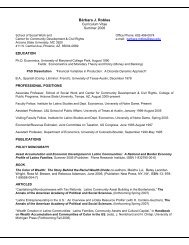Saving Patterns and Probability of Success in Individual ...
Saving Patterns and Probability of Success in Individual ...
Saving Patterns and Probability of Success in Individual ...
Create successful ePaper yourself
Turn your PDF publications into a flip-book with our unique Google optimized e-Paper software.
<strong>Sav<strong>in</strong>g</strong> <strong>Patterns</strong> <strong>and</strong> <strong>Probability</strong> <strong>of</strong> … 5<br />
difficult to separate the impact <strong>of</strong> every s<strong>in</strong>gle aspect <strong>of</strong> the sav<strong>in</strong>g plan on the probability <strong>of</strong><br />
success <strong>in</strong> reach<strong>in</strong>g the m<strong>in</strong>imum IDA sav<strong>in</strong>gs limit. In other words, even if regularity <strong>of</strong><br />
deposits <strong>in</strong> a given sample <strong>of</strong> accounts has a mean<strong>in</strong>gful correlation with success <strong>in</strong> reach<strong>in</strong>g the<br />
sav<strong>in</strong>gs limit, it is not clear how this relationship will hold, for example, if the plan required a<br />
longer sav<strong>in</strong>g period or if a higher maximum sav<strong>in</strong>gs limit was stipulated.<br />
This article puts forward the simple hypothesis that regular savers, regardless <strong>of</strong> their<br />
demographic backgrounds, average monthly deposits, <strong>and</strong> type <strong>of</strong> deposits (i.e., automatic or<br />
otherwise), st<strong>and</strong> a better chance <strong>of</strong> reach<strong>in</strong>g their sav<strong>in</strong>gs goal. 3 The methodology used here<br />
differs from other studies <strong>in</strong> that <strong>in</strong> lieu <strong>of</strong> expla<strong>in</strong><strong>in</strong>g Average Monthly Net Deposits (AMND),<br />
it is focus<strong>in</strong>g on completion <strong>of</strong> m<strong>in</strong>imum required matched total sav<strong>in</strong>gs. At every given po<strong>in</strong>t <strong>in</strong><br />
time, there are two groups <strong>of</strong> participants: those who have completed their total m<strong>in</strong>imum<br />
required sav<strong>in</strong>gs, <strong>and</strong> those who have not. The article also discusses <strong>in</strong>active savers, an issue that<br />
is not usually addressed separately <strong>in</strong> studies on this subject. In order to test the ma<strong>in</strong> hypothesis<br />
<strong>of</strong> the article, a b<strong>in</strong>ary response model is constructed. And, <strong>in</strong>stead <strong>of</strong> us<strong>in</strong>g the ADD data, a<br />
newer but smaller set <strong>of</strong> data from 2005 is used. This data set <strong>in</strong>cludes 781 IDA accounts from<br />
UWGLA’s micro-enterprise <strong>and</strong> homeownership IDA programs.<br />
This article is structured <strong>in</strong> the follow<strong>in</strong>g way. Section 2 reviews the ma<strong>in</strong> features <strong>of</strong><br />
UWGLA’s IDA program <strong>in</strong>clud<strong>in</strong>g enrollments <strong>and</strong> highlights <strong>of</strong> the sav<strong>in</strong>g plan agreement.<br />
Section 3 analyzes the sav<strong>in</strong>g behavior <strong>of</strong> IDA participants across the United Way’s partner<br />
agencies. The ma<strong>in</strong> variables <strong>of</strong> the model that will be used later <strong>in</strong> the analysis are <strong>in</strong>troduced <strong>in</strong><br />
this section. Section 4 expla<strong>in</strong>s the b<strong>in</strong>ary response model for sav<strong>in</strong>g behavior. The results <strong>of</strong> the<br />
5














